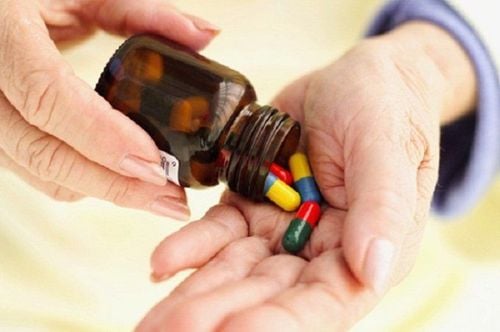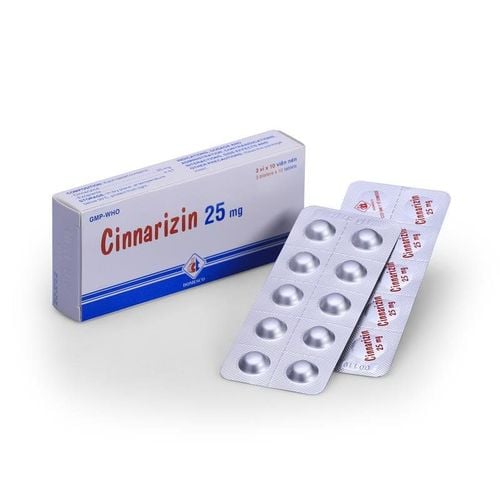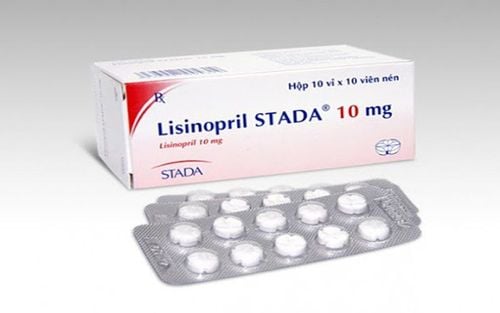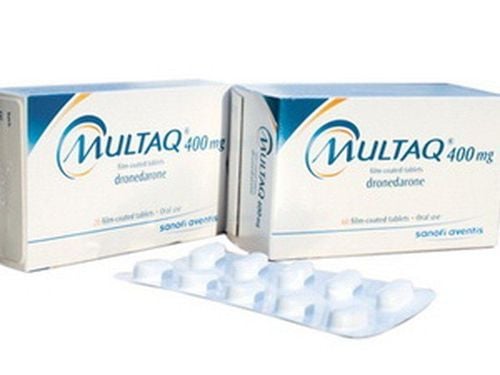This is an automatically translated article.
The drug guarente 8 has the main ingredient Candesartan cilexetil, which is used to treat hypertension and heart failure. Candesartan binds selectively and competitively with angiotensin II on the AT1 receptor in vascular smooth muscle and in the adrenal gland. This causes vasodilation, reduced sodium and water retention, and low blood pressure.
1. What is guarente 8?
The drug guarente 8 has the main ingredient Candesartan cilexeti, which is effective in the treatment of hypertension and heart failure. Candesartan cilexetil is a prodrug that, when taken orally, is hydrolyzed in the gastrointestinal tract to candesartan (active). Candesartan binds selectively and competitively with angiotensin II on AT1 receptors in vascular smooth muscle and in the adrenal glands, thereby inhibiting vasoconstriction and aldosterone secretion. As a result, guarente 8 has the effect of dilating blood vessels, reducing sodium and water retention and causing hypotension. Candesartan is not an inhibitor of angiotensin-converting enzyme (ACE), the enzyme that converts angiotensin I to angiotensin II and breaks down bradykinin. Therefore, guarente 8 has no effect on bradykinin concentrations.
In addition, candesartan also reduces albuminuria in patients with type 2 diabetes, patients with kidney disease due to other causes. Treatment with candesartan in patients with heart failure has been shown to reduce cardiovascular mortality and hospitalization for heart failure in patients with left ventricular failure. The beneficial effects of candesartan on mortality and hospital admissions were observed in all age groups and sexes.
After oral administration, candesartan cilexetil is hydrolyzed by the ester bond to the active substance candesartan. The absolute bioavailability of candesartan is approximately 40% when candesartan cilexetil is given as a solution and about 14% when administered as a tablet. Peak serum concentrations are reached 3 to 4 hours after oral administration. Candesartan is highly (over 99%) bound to plasma proteins. Candesartan is eliminated mainly unchanged in the urine and bile.
2. Uses of Guarente 8
Guarente 8 is indicated in the following conditions:
Treatment of hypertension in adults and in children aged 6 to 18 years. Treatment of heart failure in patients with impaired myocardial function.
3. Usage - Dosage of Guarente 8
3.1 How to take Guarente 8 can be taken with or without food. Food has no significant effect on the bioavailability of candesartan.
3.2. Dosage Guarente 8 drug dose depends on each patient and each disease
Hypertension:
The usual starting dose is 8mg x 1 time / day. After every 4 weeks, if BP reduction has not reached target and the patient is still tolerating the drug, increase by 8 mg/day until BP is satisfactory or to a maximum dose of 32 mg/day. Doses greater than 32 mg/day are not recommended because higher doses do not increase the effect and may increase side effects. If the dose of 32mg/day is still not effective enough, it can be combined or replaced with another drug. For patients with liver disease, kidney disease, patients with dehydration (vomiting, diarrhea,...) may prescribe a lower dose. The starting dose for patients with hepatic impairment is 2 mg/day, for patients with renal impairment or intravascular volume depletion is 4 mg/day. Maintenance dose: During dose adjustment, if BP reduction is achieved, the maintenance dose, usually 8 to 32 mg/day depending on the individual, is given once/day or in 2 divided doses. Heart failure:
The starting dose in the treatment of heart failure is usually 4mg/time x 1 time/day. After every 2 weeks in which patients do not respond, the dose may be doubled to a maximum of 32 mg/day. The patient's blood pressure should be closely monitored during dose escalation.
4. Contraindications of Guarente 8
Contraindicated to use Guarente 8 in the following cases:
Hypersensitivity to candesartan cilexetil or any component of the drug Pregnant and lactating women. Patients with severe liver failure, patients with cholestasis. Heart failure with serum potassium > 5 mmol/l, serum creatinine > 265 micromol/l (> 30 mg/l) or CrCl (creatinine clearance) < 30 mL/min (calculated from the cockcroft formula). In combination with aliskiren in patients with moderate to severe renal impairment (GFR <60 mL/min/1.73 m2 skin)
5. Guarente 8 . drug side effects
When using Guarente 8 patients may experience the following effects:
Frequency > 10%:
Cardiovascular: Lowering blood pressure; Kidney: Abnormal kidney function. Frequency 1 to 10%:
Central nervous system: Dizziness; Metabolic: Hyperkalemia; Neuromusculoskeletal: Back pain; Respiratory: Upper respiratory tract infection, pharyngitis, rhinitis. Frequency <1%:
Abnormal liver function tests, agranulocytosis, angioedema, cough, hepatitis, hyponatremia, neutropenia, pruritus, skin rash, urticaria Frequency not known Determination:
Central nervous system: Headache; Renal: Acute exacerbation of renal disease (children and adolescents), increased serum creatinine.
6. Precautions when using Guarente 8
Angioedema: Angiotensin II receptor antagonists (ARBs) have a lower risk of angioedema than ACE inhibitors. Patients with a history of angioedema due to ACE inhibitors may sometimes experience recurrence of angioedema within months of discontinuation of the drug. Regardless of the cause of angioedema, regular monitoring is required, especially if the tongue, glottis, or larynx are involved, as they are associated with airway obstruction. Guarente 8 should be discontinued immediately if the patient develops angioedema. Early management of angioedema is very important. Epinephrine may be needed. ARBs should not be used in patients with a history of angioedema due to this class of drugs. Hyperkalemia: May occur in patients receiving Guarente 8. Risk factors include renal dysfunction, diabetes mellitus, concomitant use of potassium-sparing diuretics, potassium supplements and/or potassium supplements. or salt containing potassium. Use with caution and closely monitor patients' potassium levels Hypotension: Symptomatic hypotension may occur at the initiation of therapy, particularly in patients with salt depletion or hypovolemia (eg. for example, patients treated with high-dose diuretics). Consider a lower initial dose in volume-depleted patients; if possible, correct the volume reduction prior to use. A transient hypotensive response is not a contraindication to treatment with candesartan. Impaired Renal Function: Guarente 8 may be associated with decreased renal function and/or increased serum creatinine, particularly in patients with low renal blood flow (eg, patients with renal artery stenosis, heart failure). An increase in serum creatinine may occur after initiation of treatment. Discontinuation of guarente 8 may be considered in patients with progressive and/or significant decline in renal function. Aortic/Mitral Valve Stenosis: Use with caution in patients with aortic/mitral valve stenosis. Ascites: Avoid using Guarente 8 in patients with ascites due to cirrhosis. If use cannot be avoided in patients with ascites due to cirrhosis, monitor blood pressure and function carefully to avoid rapidly developing renal failure Heart failure: Caution is advised when initiating therapy in patients with renal failure. Cardiac arrest, dose adjustment of guarente 8 and concomitant medications (eg, diuretics) may be necessary to avoid hypotension. Hepatic impairment: Increased systemic exposure in subjects with hepatic impairment. The manufacturer recommends a dose adjustment in patients with moderate hepatic impairment. The pharmacokinetics of guarente 8 have not been studied in patients with severe hepatic impairment. Renal artery stenosis: Candesartan should be used with caution in patients with unilateral/bilateral renal artery stenosis. In bilateral renal artery stenosis, the drug is generally avoided due to the high risk of impaired renal function unless the benefits outweigh the risks. Pregnancy: Drugs that act on the renin-angiotensin system can cause injury and death to the developing fetus. When pregnancy is detected, guarente 8 should be discontinued as soon as possible. The use of drugs that act on the renin-angiotensin system has been associated with oligohydramnios and may lead to decreased renal function, skeletal malformations, and fetal lung malformations. In summary, the use of guarente 8 is not recommended for the treatment of chronic hypertension in pregnant women. When guarente 8 is required in women of reproductive age with diabetic nephropathy, it should be discontinued as soon as pregnancy is detected. Lactation: Candesartan Cilexetil is excreted in human milk. Due to the potential for serious side effects in nursing infants, the manufacturer does not recommend breast-feeding while taking guarente 8. Ability to drive and use machines: Use caution when driving and operate machinery because guarente 8 can cause dizziness, hypotension, drowsiness. Treatment of overdose: Manifestations of overdose with guarente 8 are usually: hypotension, dizziness and tachycardia, sometimes bradycardia due to stimulation of the parasympathetic nervous system. If there are signs of hypotension, immediate supportive therapy should be instituted. Candesartan cannot be eliminated by hemodialysis. The above is detailed information about uses, dosage and precautions when using Guarente 8. However, the above information cannot replace instructions from medical staff. Therefore, patients need to consult their doctor and pharmacist before taking Guarente 8.Please dial HOTLINE for more information or register for an appointment HERE. Download MyVinmec app to make appointments faster and to manage your bookings easily.













